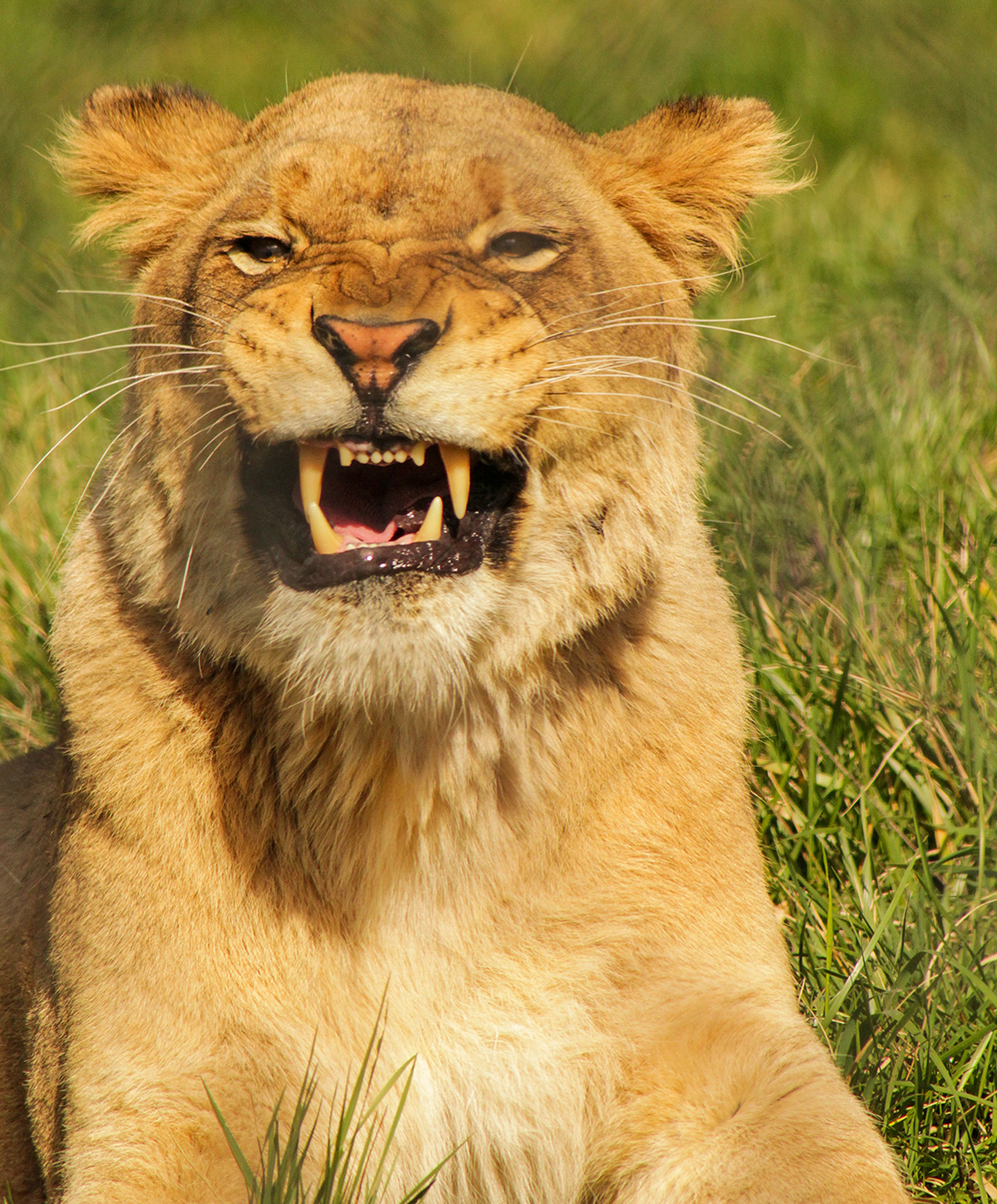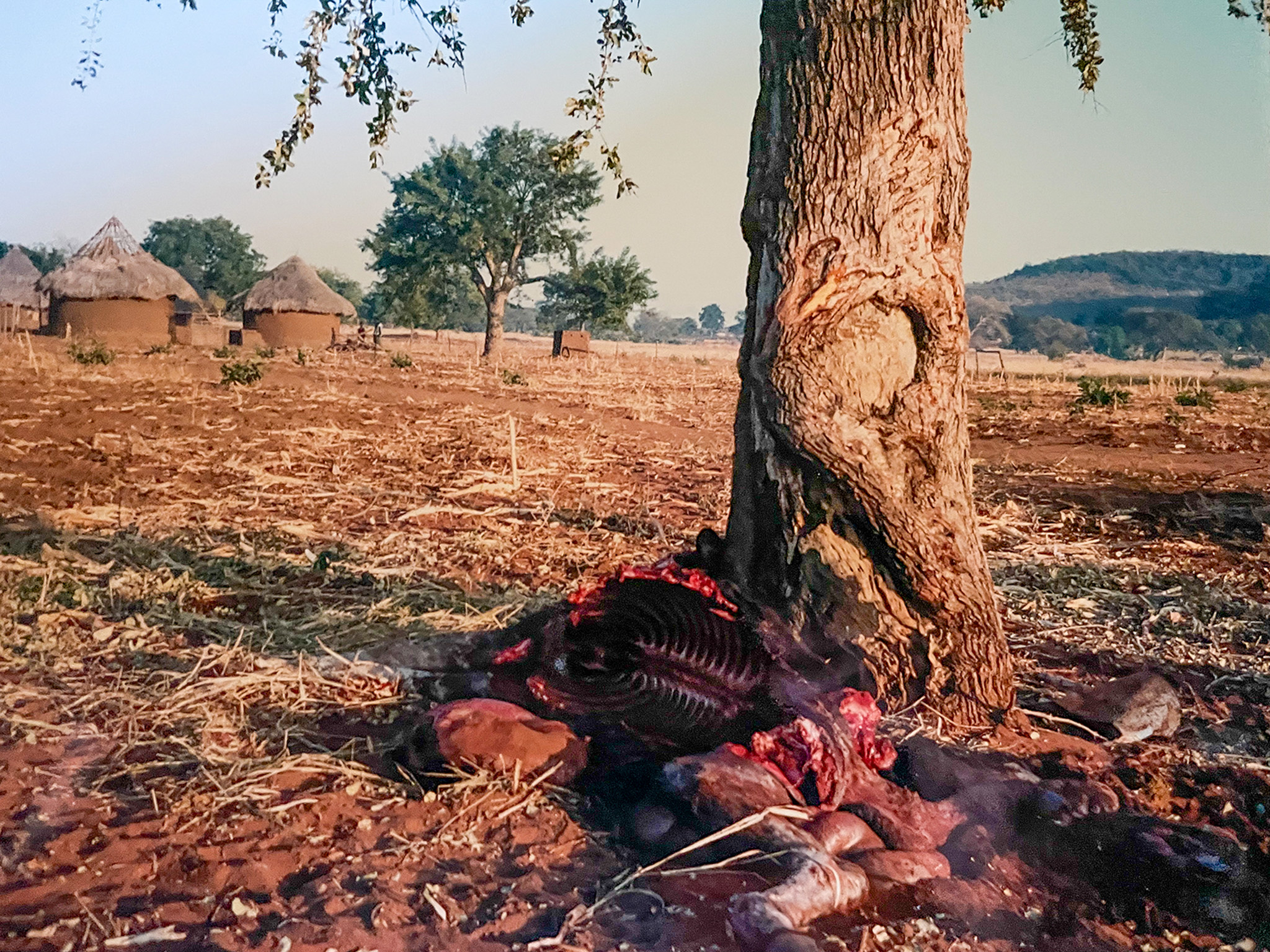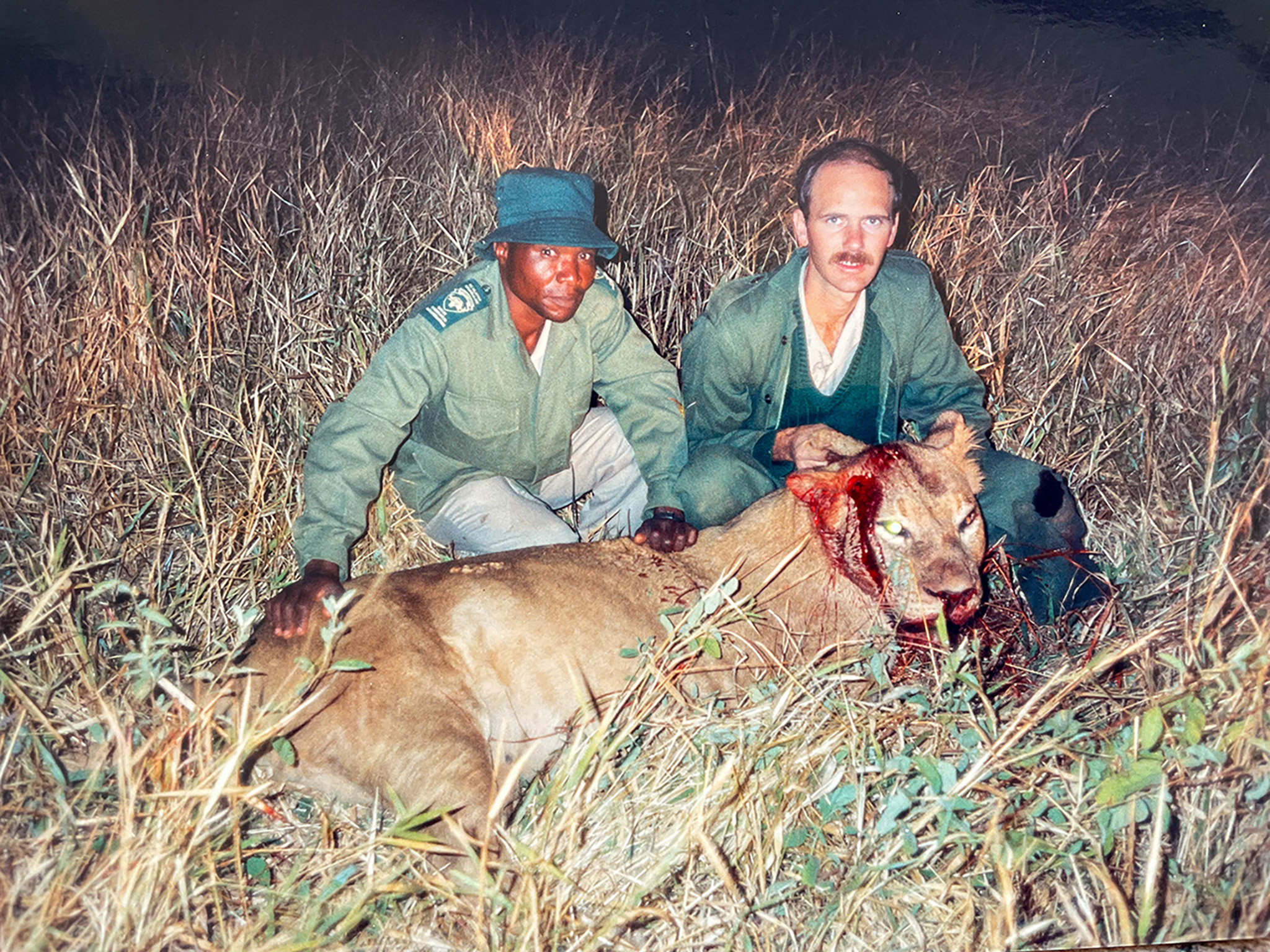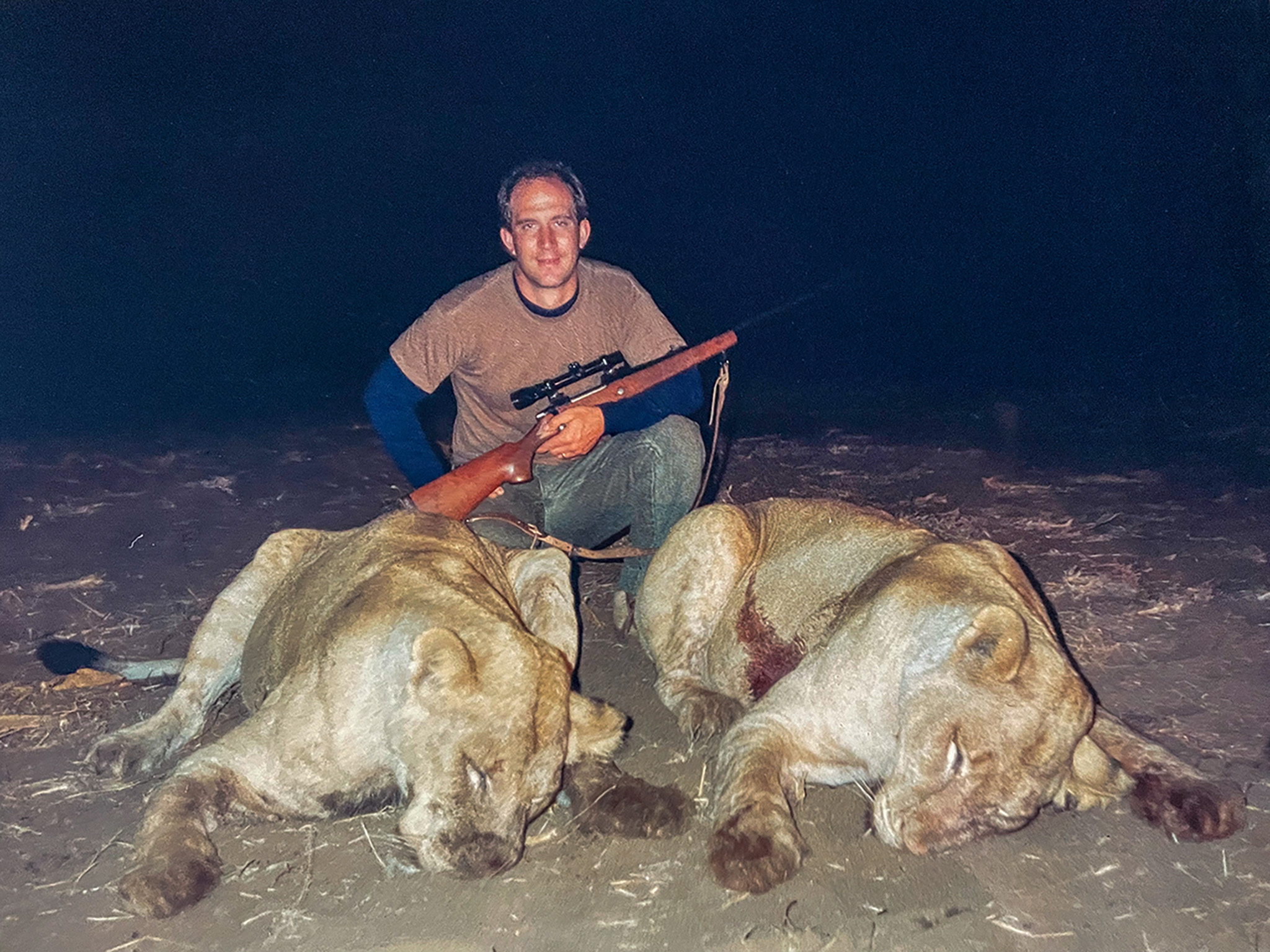We’d been sitting silently in the little ground blind for nine hours. It was 2 a.m., and it was cold. The sounds of the electronic caller no longer kept us awake.
It’s said the roar of an African lion can be heard up to five miles away. When a jolting roar shattered the silence, the cat was less than 10 yards from us. I’ll never forget the feeling of that sound. It sent shockwaves through my body. I felt pressure in my head. My feet and legs shook. I’d never experienced such a feeling, before or since. The shot of adrenaline lasted for days. I was holding a rifle, yet fear gripped me.
It was June 1993. The temperature was 28ºF, very cold for this part of South Africa even in the middle of winter. I wore jeans, two cotton shirts, a thin jacket and the same leather boots I wore sheep hunting in Alaska. I was underdressed.
We were in the northeastern corner of South Africa, in the remote native Shangaan village of Matiyani. It was here the pride of lions had grown accustomed to an easy meal. The cats were killing livestock and people in the village by night and seeking refuge in nearby Kruger National Park by day. As a rule, the cats could not be tracked back into the park and hunted, for there was no certain way to identify which cats were the killers.
For three weeks I’d been communicating with Joel, a problem-animal control officer for the South African government. I received news of Matiyani’s lion problem via fax in the remote village of Point Lay, Alaska, which was my home at the time. We had no internet, and international phone calls were exorbitant back then.
Every time the lions killed, Joel would send a fax. By the time I’d left Alaska, it had been nearly a week since I’d heard from him. But my plans were already set to arrive in Johannesburg, get a car, and drive north to Joel’s home near Pretoria. If he’d taken care of the problem cats prior to my arrival, he assured me there would still be plenty of work.
I’ll never forget the feeling of that sound. The roar sent shockwaves through my body. I felt pressure in my head. My feet and legs shook. I’d never experienced such a feeling, before or since. I was holding a rifle, yet fear gripped me.
Joel is an American who married a South African woman, moved there, and got the animal-control job without much in the way of credentials. Joel had never hunted before, and thought he’d be managing mice, rats, and snakes. His first call was to hunt down a pride of seven lions that had killed the tribal leader’s wife in a remote village. He did. It wasn’t pretty, but he accomplished it. That two-day quest taught him a lot.
“People are killed by wild animals every day over here,” Joel told me, “but the world never hears about it.”
Joel is the only person I’ve ever met whom I would write a book about. By the time I met up with him, he’d had eight years of experience and had been on hundreds of calls for problem lions, leopards, hippos, crocs, and elephants. Man-eaters were Joel’s specialty.
Living in Terror
I arrived at Joel’s house a few minutes before midnight. It struck me as odd that when I pulled up he was awake, loading his truck.
“We must go, quickly. The cats killed only a few hours ago,” Joel said, and pointed. “Grab your gear, load it into that truck, and let’s go.”
His voice was calm but it was urgent, too. For three weeks Joel had been hunting this pride. But because the lions were moving unpredictably and killing at night, it made intercepting them difficult.
Photo by Scott Haugen
The daily lives of the Matiyani residents were being governed by the lions. There was no electricity in the village to help keep the lions at bay, so by day people gathered wood and straw to burn at hut entrances and around livestock barricades at night. This ploy worked, but not for long. Soon the cats grew fearless of the flames, entering the village wherever and whenever they pleased. They grew so bold they began pulling people from the huts in which they slept.
It was a long drive to the village. The dirt roads were pocked with potholes which further slowed our progress. By the time we arrived, the sun cast an orange hue across the flat horizon.
Every evening an eerie silence fell upon Matiyani. All was quiet, and no one could be seen. They were afraid, sheltering in their mud-and-stick huts and wondering what animal, or who, would be the next victim. The wealth of villagers was measured not by money, but livestock. Every animal lost was a setback and they had no weapons, which were forbidden by law.
A ranger met us on our arrival. Joel translated, telling me how the lions routinely poked their heads into the huts. It wasn’t the sound of a marauding man-eater that often woke the villagers, but the smell of the lion’s putrid breath.
When the warden took us to the recent kill site, villagers swarmed us. We were jolted to see where it had taken place: Directly in front of the doorway to a hut, three goats and a pig had been killed and eaten within six feet of a doorway. To reach this spot, four lions had jumped a five-foot fence of branches and small limbs, then ignored the fires to massacre their prey. The residents, just feet away inside their huts, had heard every crunching bone and tearing of flesh of their valued livestock as it was devoured. With no way to defend themselves, villagers sat in silence, hoping the cats got their fill. The ordeal had lasted nearly two hours.
By mid-day, Joel had a plan. We secured a donkey from the warden, reassuring him it was our intent to return it, unscathed. That afternoon we built a ground blind 75 yards from a lone tree in a hand-plowed field. Joel determined this to be the optimal distance where the beam of his flashlight could illuminate the cats without spooking them, and still see the crosshairs of the 4x scope atop his government-issued .375 H&H Magnum.

Photo by Scott Haugen
Before dark we tethered the donkey to the tree. As Joel learned early in his career, livestock in this region wore bells around their necks, and lions would often become conditioned to associate the sound with a meal. So we hung a cowbell in a tree over the donkey’s head, tied it to a string, and ran the string all the way to our blind. That way when the donkey stood still for too long, we could tug the string and alert the cats to its location.
Last, we situated a loudspeaker 10 yards from our blind. Ten feet of cord was all Joel had for the electronic caller: a cassette tape of various livestock in distress. We hoped to pull the lions out of the park.
Calling Big Cats
After nine hours of incessant calling and hearing nothing but hyenas, we were cold and tired. Joe, his assistant, and I were huddled in the tiny blind, but we dared not move to warm ourselves. At last we were ready to call it quits and we turned off the e-caller. The stillness of the African night enveloped us. I looked over my gun barrel and out a tiny hole in the blind that revealed the clear, star-studded night. It was peaceful. The cats just weren’t interested. Maybe they were full from the night before.
Jet lagged and growing delirious, I felt my mind drifting as the laughter of hyenas waned in the distance. Then, without warning, a lion near our blind erupted with that guttural roar. It had stalked exactly to our speaker.
Again, the shattering sound of the lion’s roar broke the silence, causing my skin to shrink even tighter. The cat’s breathing intensified, followed by deep growls. It was pitch-dark inside the blind.
We sat in dead silence, curious as to the lion’s next move. Minutes slowly passed without a sound. Finally, the stillness was interrupted by the crunching of bones. The pride had found our bait. The donkey had fallen asleep, and had never made a sound.
That’s how the cats attacked: silently and with coordination. One lion would grab the muzzle, another the throat, and a third the back of the neck at the base of the skull. The donkey died quickly, at least. The first roar we had heard, Joel later explained, likely came during the kill, which also masked any sounds we may have heard.
Allowing the cats time to settle in, Joel waited a few minutes before turning on his flashlight. Even from a distance, the rasp of cat tongues licking raw, smooth flesh was eerily audible.
Then Joel tapped me on the leg. This was the signal that he was turning on the flashlight. Staring through the riflescope, I saw only darkness. My safety was off, finger on the trigger.
Staring through the riflescope, I saw only darkness. My safety was off, finger on the trigger.
As the light reached the base of the tree, I saw four adult lionesses feeding on the kill, two lying on each side.
As the light reached the base of the tree, I saw four adult lionesses feeding on the kill, two lying on each side. They seemed massive in the little scope. Not wanting to risk a bullet passing through one cat and crippling another, I waited. Joel turned off the light.
After 15 minutes of flipping the light on and off every few minutes to check their positions, a cat on the left side of the donkey finally stood. For the first time I had a shot. No one said anything.
I pressed the trigger and the 275-grain soft point found its mark. All four cats bolted. The one I had shot piled up 20 yards from where it was hit.
We ran the electric call again, increasing the volume. It took only 15 minutes for the three remaining cats to return. Two ran past the dead lioness and immediately resumed feeding. The third paused, giving Joel’s assistant a shot opportunity. A well-placed bullet sent the cat on a death run. Two down.

Photo by Scott Haugen
With Joel still manning the light and the e-caller blaring again, I slid into shooting position. Five minutes later, the two cats returned. One started eating. The other stood looking at the bait, broadside. The shot was simple and I took it, hitting tight behind the lion’s shoulder. Only afterward did I realize how relaxed, yet so very focused, I’d been.
For nearly an hour we tried calling in the last lioness. She wasn’t cooperating. Doubtful the cat would take the bait a fourth time, Joel decided to go after it.
Into the Tall Grass
We walked. I held the flashlight while Joel manned the rifle. The assistant stayed back, should our plans go awry. The flat dirt field gave way to a curtain of tall, stiff, yellow grass. We had examined this area in the daylight and noticed the cat’s trails led through it and into Kruger Park, a boundary less than 200 yards away.
“You must hold the light steady, do not move it quickly,” Joel instructed before we entered the grass. I couldn’t see his face. I didn’t need to. “Look for the cat’s glowing eyes. They will be yellow and surprisingly big. Once you make contact, do not move the light. It must stay on the eyes at all times.”
We eased toward the spot where we’d last seen the cat. Tall grass consumed us. I held the light in my left hand, keeping track of Joel with my right. Fewer than 20 steps into the grass that grew over our heads, we saw the lion’s gold, glowing eyes. They were shockingly bright and large, just as Joel said they would be.
The cat’s head was up. But as soon as the flashlight beam steadied its head dropped, chin flat to the ground. Its eyes stayed open. We walked quickly now, heading straight at them. The cat was only 30 yards away but the grass was too thick to risk shooting through. We had to close the distance before the cat moved.
I’d dealt with a man-eating polar and other problem bears in Alaska, so I wasn’t unfamiliar with the work cut out for us. I still learned a lot from Joel, whose nerves of steel were invaluable. He coached me on this while walking across the flat dirt field in the dark.
Then, as swiftly as the cat’s glowing eyes had appeared, they vanished. It was a sobering moment. I felt helpless. Joel was on the gun, its barrel just ahead of my right ear, following the beam of my flashlight as I frantically searched for the cat. I picked up the eye again, this time 30 degrees to our right. We walked fast, light steady on its face. Again, the eyes disappeared.
It took longer this time, but when I finally picked up the amber eyes of the cat, it had worked nearly 60 degrees to our side. She was hunting us now.
“This is not good, she’s trying to circle in behind us,” whispered Joel. “We must back out of here, slowly. Keep the light pointed to where you last saw the cat. Do not turn your back.”
It took an eternity to back out of the tall grass. It seemed thicker and harder to walk through now. Even when we reached the field, Joel had me keep the light trained on our back trail. He stayed on the gun, safety off.
We retreated past two of the dead cats in the dirt field but didn’t pause for inspection. We were reeling from what had just happened, focusing on the task ahead.
The Last of the Man-Eaters
When we returned to Matiyani, Joel spoke with a ranger who knew the land well. I hopped behind the wheel of Joel’s Toyota, his assistant beside me. The ranger and Joel climbed in the back. The ranger held the flashlight and Joel held his rifle.
“Just follow the beam of the flashlight,” Joel instructed me. “The tall grass is going to be above the hood, you won’t be able to see anything. Turn your headlights off so you can see the light and just keep following it. I don’t want any glare from the headlights on the grass. When I knock on the roof, stop, and sit still. Do not move. The truck must be steady.”

Photo by Scott Haugen
We hit the tall yellow grass and I followed the beam of the flashlight. Slowly we inched forward. I strained to see through the yellow curtain of grass as it folded beneath the front bumper. It was too tall, too thick.
An urgent rap on the roof brought me to a sudden stop. The light was locked on the grass in front of us, then a blaze of orange fire shot down across the windshield. An immediate followup shot confirmed the first was not a misfire.
Peering into the grass I caught a glimpse of something at last: a lion’s tail twitching from side-to-side. After its body relaxed, I turned the headlights on and we gathered around the lifeless lioness.
Blood streamed from a bullet hole above the right eye. Joel had made a perfect shot, striking the lion as she spring-loaded for the final lunge, 3 feet from the truck. The cat was crouched and running fast, right at us when Joel shot. His shot had been a reaction. It was intentional and precise. Had Joel missed, the cat would have jumped over the hood of the truck, claiming either the ranger or Joel himself.
One by one we gathered the four dead lions. We lined them up near the tree with the dead donkey. Roosters in the village began crowing as dawn broke. At first light, villagers poured from their huts, running to confirm that the lions were dead. Chanting and celebration followed. The demon cats were gone.
As is often the case, female lions did the killing. When skinning these cats, never had I seen such a perfectly-equipped killing machine. Their jaw muscles were as dense as steel and strong enough to crush a human skull with one bite. The long canines and powerful legs — capable of bringing down a cape buffalo — were simply awesome. I’ve seen lions take down giraffes, buffalo, and plains game. They make it look easy. Now I understood why.

Photo courtesy of Scott Haugen
Joel and I skinned and quartered all four cats. We delivered meat to villages on the opposite end of Joel’s jurisdiction. Everyone was happy to have fresh meat, and at 300 pounds apiece from each lion, many meals were provided to people in need. We didn’t mention they had been man-eaters.
Read Next: I Was Nearly Killed By a Drug Cartel While Turkey Hunting in Mexico
Joel and I kept one backstrap and a hindquarter roast. Lion meat is mild, firm but not tough. It’s delicious. Years later I’d eaten mountain lion back home and this tasted the same, though it was the first man-eater I’d ever killed and eaten.
I spent nearly two weeks with Joel. We tended to other problem animals. As a thank you for my help, Joel was able to get the hides of the two man-eaters I shot released to me. One is mounted, life-size, in my office, the other is a full rug. Every day I’m home I look at these two cats. Even in death they exude a powerful, daunting feeling, and bring back vivid memories of what happened one night in Africa more than 30 years ago.
